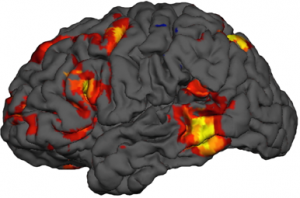Data Collection in the fMRI Environment (Human)
Date
Wednesday, April 11, 2018
Location
On-demand: Watch Recording

Physiological data collection during magnetic resonance imagining (MRI) requires special consideration. Researchers need to ensure strong physiological signals while avoiding potential dangers for the participant. Understanding the issues around safety, set up and specialized equipment is important when collecting psychophysiology data inside the scanner. Jennifer Robinson, Ph.D., Auburn University, expert in functional MRI & psychophysiology, will present recommendations for successful fMRI data collection. Join Dr. Robinson and Frazer Findlay, CEO of BIOPAC, for a deep dive into the world of fMRI data collection. What You Will Learn
Related Webinars: | Complete Form to Watch Webinar! |
About Jennifer Robinson, Ph.D.
Jennifer L. Robinson, Ph.D. received her Ph.D. from Case Western Reserve University in experimental psychology, where she was trained on psychophysiological methods. She completed a psychiatric neuroimaging postdoctoral fellowship at the University of Texas Health Science Center at San Antonio. Following her postdoctoral fellowship, she created and directed a functional neuroimaging program at Scott & White Healthcare (now Baylor Scott & White) in Temple, Texas, where she combined psychophysiological methods and functional magnetic resonance imaging (fMRI). Dr. Robinson is currently an Associate Professor at Auburn University, where she directs the Cognitive and Behavioral Sciences Ph.D. program as well as her laboratory, the Cognitive and Affective Neuroscience Laboratory, which utilizes a MR-compatible psychophysiological suite. Her research revolves around understanding the complex relationships between the brain and body as they relate to emotional processes, stress, and cognition. Additionally, she continues to pursue new techniques and methods using ultra high field neuroimaging, especially with regard to integration of psychophysiological measurements.
About Frazer Findlay
 Frazer is CEO of BIOPAC and has more than 20 years’ experience in life science data acquisition and analysis. Frazer is a well-regarded expert in the physiology monitoring industry and has facilitated workshops in the U.S., Europe, and Asia. He is familiar with a variety of software, equipment, and laboratory protocols for a wide array of signals and measurements.
Frazer is CEO of BIOPAC and has more than 20 years’ experience in life science data acquisition and analysis. Frazer is a well-regarded expert in the physiology monitoring industry and has facilitated workshops in the U.S., Europe, and Asia. He is familiar with a variety of software, equipment, and laboratory protocols for a wide array of signals and measurements.
For more information about BIOPAC events, check the BIOPAC Events Calendar or email support@biopac.com.
Stay Connected